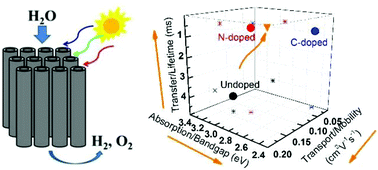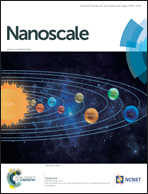Standalone anion- and co-doped titanium dioxide nanotubes for photocatalytic and photoelectrochemical solar-to-fuel conversion†
Abstract
Several strategies are currently being investigated for conversion of incident sunlight into renewable sources of energy, and photocatalytic or photoelectrochemical production of solar fuels can provide an important alternative. Titanium dioxide (TiO2) has been heavily investigated as a material of choice due to its excellent optoelectronic properties and stability, and anion-doping proposed as a pathway to improve light absorption as well as improving the efficiency of oxygen production. While several studies have used morphological tuning, elemental doping, and surface engineering in TiO2 to extend its absorption, there is a need to optimize simultaneously charge transport and improve interfacial chemical reaction kinetics. Here we show anion-doped (nitrogen, carbon) standalone TiO2 nanotube membranes that absorb visible light for the water-splitting reaction, using both wireless (photocatalysis) and wired (photoelectrochemical) solar-to-fuel conversion (STFC) cells. Using simulated solar radiation, we show generation of hydrogen as a solar fuel using visible light photocatalysis. Furthermore, using a model we elucidate detailed photophysics and photoelectrochemical properties of these nanotubes, and explain the kinetics of photogenerated charge carriers following light absorption. We show that while visible light induces a superlinear photoresponse for catalytic reduction and may benefit from higher incident light intensity, ultraviolet light shows a linear photoresponse and saturation with higher light flux due to trapping of photogenerated charges (mainly electrons). These results can have important implications for design of other metal–oxide membranes for solar fuel generation, and appropriate design of dopants and induced energy levels in these photocatalysts.


 Please wait while we load your content...
Please wait while we load your content...